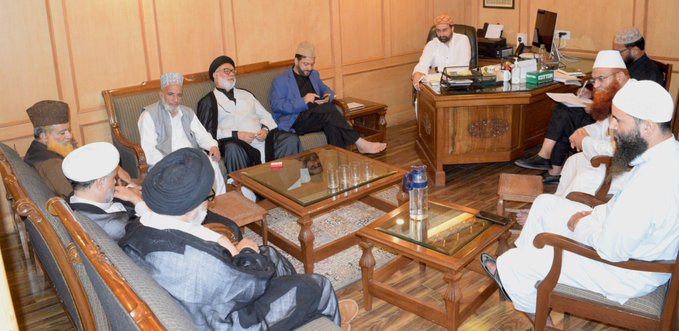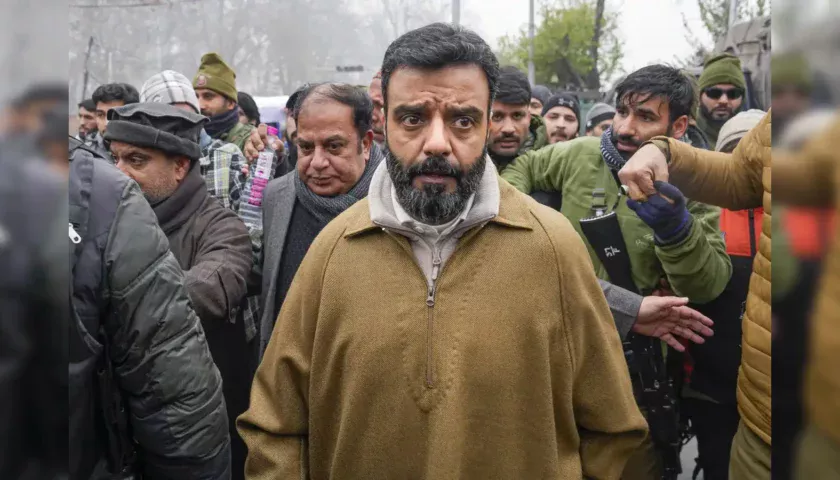Hazratbal Shrine: More Than a Monument
By: Javid Amin | 06 September 2025
The Hazratbal Shrine is not just another mosque in Kashmir. For centuries, it has stood as a spiritual heartbeat of the Valley, deeply tied to the faith, memory, and identity of Kashmiri Muslims. Housing the revered relic of Prophet Muhammad ﷺ, Hazratbal commands a sanctity that transcends generations.
Unlike other shrines, Hazratbal has always been marked by simplicity, humility, and deep spiritual reverence. Worshippers see it not merely as a building but as an extension of their collective soul. That is why any change within its premises — however minor — evokes powerful reactions among the faithful.
So when a plaque with the Ashoka Chakra was installed recently as part of refurbishment works, it sparked unease, anger, and sorrow.
MMU Steps In: The Voice of Unity
The Mutahida Majlis-e-Ulema (MMU) — Kashmir’s largest religious conglomerate led by Mirwaiz Umar Farooq — issued a strong statement against the installation.
Their objections were rooted not in politics alone but in deep theological and historical principles:
-
Islamic injunctions prohibit plaques, emblems, or symbols within mosques and shrines.
-
Kashmir’s own history affirms this rule: even during past reconstructions of Hazratbal, no plaques or foundation stones were ever placed.
-
Sanctity over symbolism: shrines are meant to be spaces of prayer, not places for state or institutional branding.
The MMU argued that the move sets a dangerous precedent, blurring the line between sacred spirituality and political display.
A Clash of Principles: Faith vs Symbolism
The Ashoka Chakra, as India’s national emblem, holds constitutional importance. It symbolizes law, justice, and sovereignty. But in the context of Hazratbal, it collided with another deeply rooted principle: Shari‘ah-based restraint against man-made symbols in sacred spaces.
The MMU’s statement carefully balanced respect for the nation with defense of faith:
-
They did not object to the emblem per se.
-
Their objection was to its placement in a shrine, where symbols — even religious ones — are discouraged.
-
For Muslims, introducing such emblems risks diluting the spiritual sanctity of mosques into platforms of authority or politics.
This careful articulation shows the MMU’s nuanced position: it is not about opposing the state, but about protecting the essence of Islam’s sacred spaces.
People’s Reaction: Faithful Yet Frustrated
For ordinary Kashmiris, Hazratbal is a sacred inheritance. Their reaction to the plaque was not political agitation but religious grief.
-
Worshippers protested, voicing their pain over what they saw as a violation of shrine sanctity.
-
Their protest was largely peaceful, yet FIRs were reportedly filed against some of them.
This, according to MMU, added insult to injury. Instead of listening to heartfelt concerns, authorities chose punitive measures.
📢 “Matters of religion must be resolved with understanding and dialogue, not through harsh steps,” the MMU stressed.
Waqf Board Under Scrutiny
At the heart of the controversy is the J&K Waqf Board, custodian of Hazratbal and dozens of other shrines.
The MMU questioned its decision-making process:
-
Why was there no consultation with religious scholars before installing the plaque?
-
Why ignore the long-standing Islamic injunction against emblems?
-
Does this act reflect a shift towards symbolism over spirituality in shrine management?
For many Kashmiris, the Waqf Board is seen not just as a caretaker of buildings but as a trustee of faith itself. When it falters, the impact is felt deeply.
Tradition Speaks: The Historical Precedent
History provides clarity. Hazratbal has been rebuilt, refurbished, and expanded multiple times. Yet never once were plaques or foundation stones placed inside its sacred space.
This was deliberate: a way to preserve the purity of the shrine and avoid any worldly display. The MMU reminded the Waqf that tradition is not to be broken lightly, especially in matters tied so deeply to faith.
By introducing plaques now, the Waqf risks rewriting centuries of sacred precedent.
MMU’s Core Demands
The MMU’s statement was not mere criticism. It carried clear, constructive demands:
-
Immediate Removal of the Ashoka Chakra plaque from Hazratbal.
-
No Punitive Measures against worshippers who protested in good faith.
-
Consultation with Ulema before undertaking any future works at shrines.
-
Respect for Shari‘ah Principles and Kashmiri religious tradition in shrine management.
These demands reflect a desire for dialogue, dignity, and respect for faith rather than confrontation.
Political Undercurrents: Why This Matters
While MMU’s statement is rooted in religion, the controversy has political ripples:
-
In today’s Kashmir, where religious and political identities overlap, even small symbolic acts trigger larger debates about autonomy, culture, and governance.
-
For New Delhi, showcasing national symbols in Kashmir’s sacred spaces may be seen as assertion of integration.
-
For Kashmiris, however, it may feel like an intrusion into spiritual sanctity.
Thus, what looks like a “plaque issue” is in fact a mirror to larger anxieties — about identity, respect, and space for local traditions within the broader national framework.
Dialogue Over Division
The MMU’s tone was notable: it urged restraint, dialogue, and consultation. By doing so, it prevented the issue from snowballing into street-level unrest.
This approach highlights the importance of dialogue in conflict-prone societies. When faith and politics collide, listening is more powerful than imposing.
If authorities take MMU’s advice seriously, this controversy could become a moment of reconciliation rather than division.
Wider Implications: Faith in a Changing Kashmir
This episode raises larger questions:
-
How should shrines be managed in a region where faith and politics are deeply intertwined?
-
Should custodians prioritize symbolism of state power or purity of faith?
-
Can dialogue between religious leaders and authorities build trust in times of suspicion?
Hazratbal’s plaque issue is not isolated. It is part of a broader conversation about Kashmir’s identity in a changing political climate.
MMU’s Broad Base: A Collective Voice
The strength of MMU lies in its diversity. Its signatories include nearly every major religious, educational, and social institution in Kashmir — from Anjuman Auqaf Jamia Masjid to Darul Uloom Rahimiyah, from Karwan-e-Islami to Anjuman Sharie Shian, from Jamiat Ahle Hadith to Imamia Federation Kashmir.
This wide base means the MMU does not speak for a faction — it speaks for the collective conscience of Kashmir’s religious community.
When such a body speaks in unison, its voice carries moral authority difficult for any government or institution to ignore.
The Road Ahead: Preserving Sanctity, Building Trust
The Hazratbal plaque controversy is not just about stone and metal. It is about hearts, heritage, and faith.
If resolved with sensitivity:
-
It could strengthen trust between religious institutions and the Waqf.
-
It could set a healthy precedent for respecting faith in development works.
If ignored:
-
It risks fueling distrust, alienation, and unnecessary confrontation.
The path forward is clear: dialogue, respect, and humility.
Conclusion: Hazratbal as a Test of Respect
Hazratbal Shrine is not just Kashmir’s sacred space; it is a litmus test of how faith, identity, and governance intersect.
By calling for the removal of the plaque, MMU is not opposing progress but defending purity. By asking authorities to consult scholars, they are not resisting integration but seeking dialogue.
The message is simple yet profound: faith deserves respect, not imposition.
If that lesson is heeded, Hazratbal will continue to shine not just as a mosque, but as a symbol of harmony between tradition and change.




